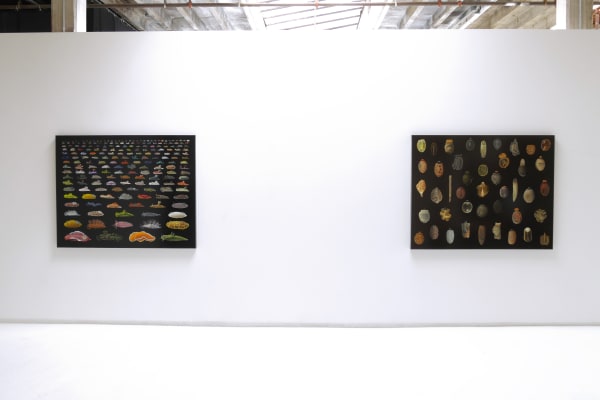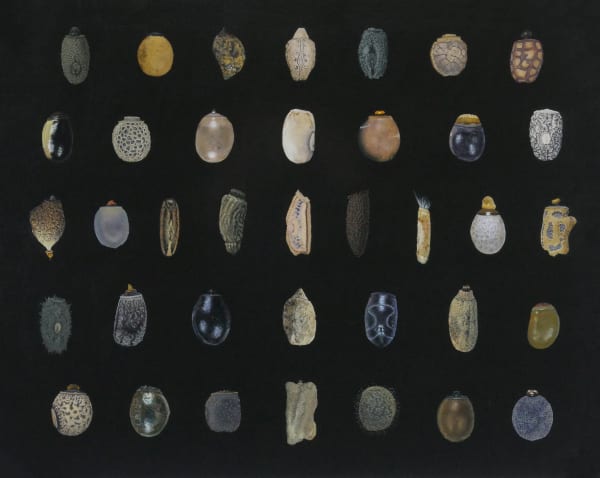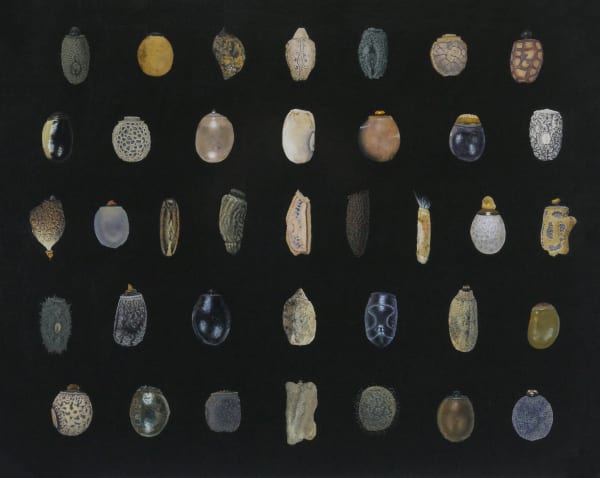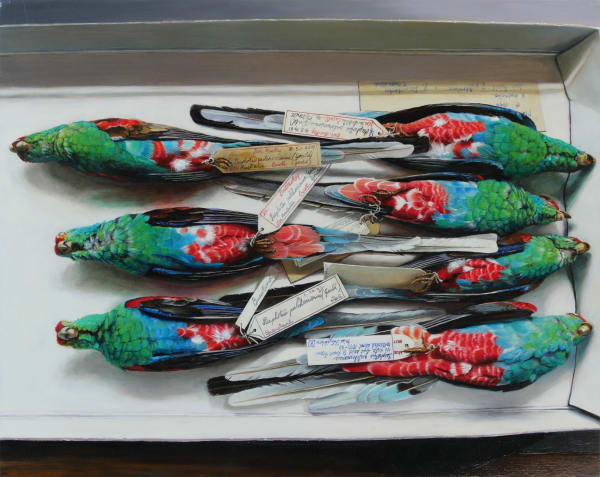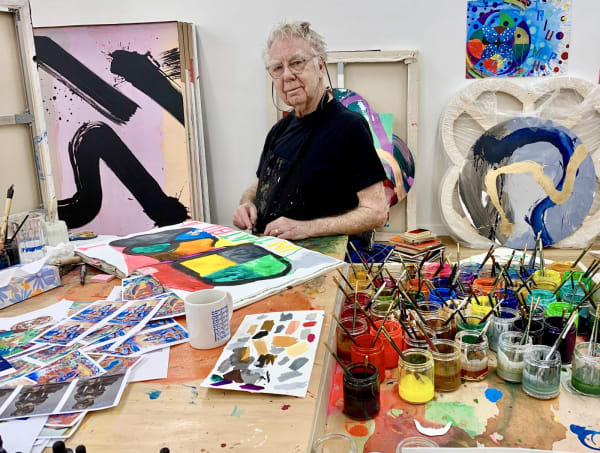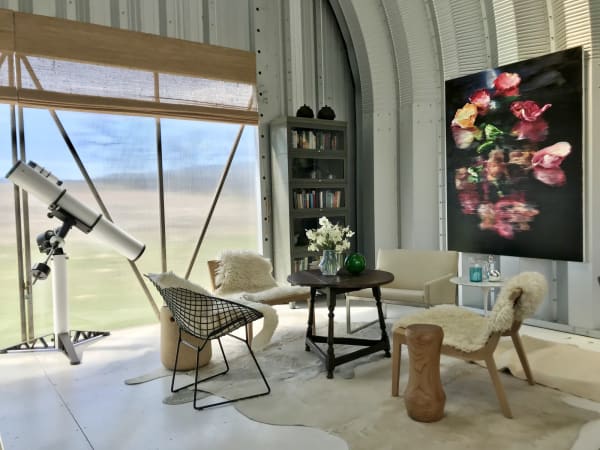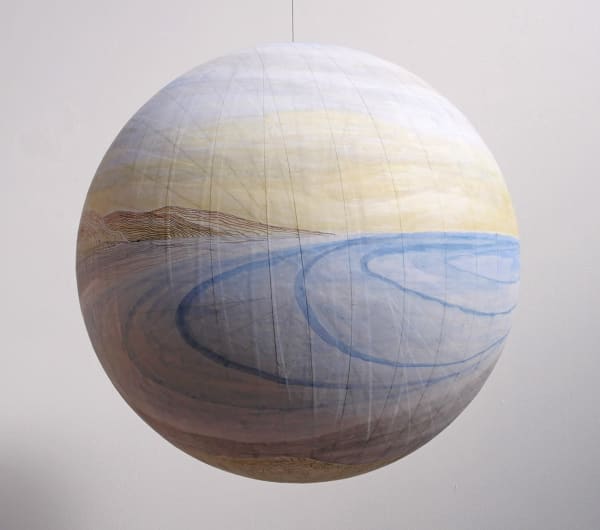“There is an antique quality of the work I do. I think of this realistic style as a warp thread I chose to pick up and work with after our centuries’ long hiatus from realistic painting. Accurate descriptive depiction of plants and animals has served the biological sciences practically since the invention of the printing press. The lion’s share of this service has been for the purposes of diagnostic differentiation. Post Linnaeus, scientific illustration has functioned as a tool of speciation: often highlighting those traits or markers that signify a particular species, while downplaying less defining visual characteristics.
"I choose to apply a similar accuracy to a different service: to the building of an analog visual record of what we are going to lose in the coming centuries. I want the images I build of select, representative species to stand witness to their own loss… just as Guernica stood witness to a political massacre, and the painting, The Raft of the Medusa, bore witness to the sinking of a naval vessel.
"Using old methods I hope to make a meaningful set of iconic images that record, identify, represent, and bear witness to the fate of individual species. We are all inundated with digital data and visuals while simultaneously maddened by the speed with which our own digital records become outdated and obsolete by new operating software. Printing inks are notoriously short lived as you can easily see if you open an illustrated book from the 1950’s: the colors have decayed in just a half century.
"I have painted these biota as accurately as I have found possible, researching each extensively in natural history collections and herbaria, using methods and materials of the highest conservatorial standards. I paint in the time-tested medium of oils so that, assuming the paintings survive the ravages of time, these works will stand mute witness to some of the life forms lost during this Anthropocene Era.” – Isabella Kirkland
-

OFF THE GRID: Post-Formal Conceptualism
11 Apr - 20 May 2023This sprawling group exhibition traces the use of the form of the grid in contemporary art, beginning with some of its most illustrious mid-20th century proponents. From there, it examines...Read more -

Where We Are
23 Oct - 24 Nov 2021In a group exhibition marking this moment in history (and celebrating the 25th anniversary of Hosfelt Gallery) the work of 34 artists is employed to reflect on the zeitgeist of...Read more -

Isabella Kirkland
THE SMALL MATTER 1 May - 12 Jun 2021Self-taught in the meticulous and time-consuming techniques developed by 17th century Dutch painters, Isabella Kirkland directs her technical proficiency and rarefied access to biological specimen collections and scientific experts towards...Read more -

BETWEEN THEM
An Installation Composed of Drawings 13 Jul - 17 Aug 2019Todd Hosfelt combines approximately 200 drawings in an installation designed to reveal thematic and conceptual relationships across time and place. In drawings spanning the 16th to 21st centuries, from European...Read more -

Frankenstein’s Birthday Party
23 Jun - 11 Aug 20182018 is the bicentennial of Mary Wollstonecraft Shelley’s novel, Frankenstein; or, The Modern Prometheus . Why does a 200-year-old ghost story continue to feel so relevant? It’s important to remember...Read more
-

Isabella Kirkland at Ted Countdown '23
Ted.com, July 14, 2023 -

The Grid Revisited
David M. Roth, Squarecylinder, May 1, 2023 -

The Power of Attention: How Isabella Kirkland's work stands witness to nature’s losses and gains
Heather Rivéun, Kinute, September 22, 2022 -

Rising Tide #64 – Isabella Kirkland’s Art of Nature
Blue Frontier, Blue Frontier, August 29, 2022 -

Isabella Kirkland at The Art Show
December 8, 2021 -

The Nature Conundrum
David M. Roth, Squarecylinder, June 2, 2021 -

Renny Pritikin on Isabella Kirkland @ Hosfelt
Renny Pritikin, Squarecylinder, May 10, 2021 -

‘I Like Drawings”: A Conversation with Todd Hosfelt
Justin Manley, SquareCylinder, August 5, 2019 -

Best of 2018
David M. Roth, Squarecylinder, December 22, 2018 -

Frankenstein’s Birthday Party @ Hosfelt
Justin Manley, Squarecylinder, July 20, 2018 -

Summer exhibition at Hosfelt Gallery a monstrous affair
Charles Desmarais, San Francisco Chronicle, July 6, 2018 -

Isabella Kirkland: ‘Nova’
Ken Johnson, The New York TImes, June 9, 2011 -

On the Origin (and Fate) of Species
Andrew C. Revkin , The New York TImes, February 13, 2009
-

HG Magazine Issue no. 38
Earth Day April 21, 2022Christian Houge's 'Death of a Mountain' series Lordy Rodriguez's 'Lake Karachay' and 'Four Rivers' Combatting food waste Gallery Climate Coalition carbon audit & other actions...Read more -

HG Magazine Issue no. 30
Celebrating William T. Wiley; plus African Butterfly Research Institute, THE SMALL MATTER exhibition review, bug brownie recipe May 18, 2021Celebrating the life of William T. Wiley (1937-2021) African Butterfly Research Institute Renny Pritikin reviews Isabella Kirkland's THE SMALL MATTER in SquareCylinder In the Shop:...Read more -

HG Magazine Issue no. 29
Isabella Kirkland: THE SMALL MATTER & Patricia Piccinini: The Awakening open; plus Rina Banerjee on 8-Bridges, Cornelius Völker, biscuit recipe April 29, 2021Opening May 1: Isabella Kirkland: THE SMALL MATTER & Patricia Piccinini: The Awakening Rina Banerjee on 8-Bridges Art @ Home New to Inventory: Cornelius Völker...Read more -

HG Magazine Issue no. 28
Studio Visit with Birgit Jensen; plus Liliana Porter, Ben McLaughlin, Isabella Kirkland, Patricia Piccinini, Cornelius Völker April 16, 2021Closing soon - Liliana Porter: The Riddle / Charada & Ben McLaughlin: Ex Libris Upcoming at the Gallery - Isabella Kirkland: THE SMALL MATTER &...Read more -

HG Magazine Issue no. 27
Liliana Porter in the press & virtual event; plus Ben McLaughlin, Rina Banerjee, Isabella Kirkland, Patricia Piccinini, Max Gimblett, Lordy Rodriguez, Bruce & Jean Conner April 3, 2021Liliana Porter in Artforum and Artsy In Conversation: Liliana Porter & curator Humberto Moro Ben McLaughlin: Artwork Explained Art @ Home New to Inventory: Rina...Read more -

HG Magazine Issue no. 24
ASSEMBLED: Bruce Conner / Jean Conner / Anonymous / Anonymouse / Emily Feather / Signed In Blood; plus Isabella Kirkland, Patricia Piccinini, Russell Crotty, Jutta Haeckel, Gallery Climate Coalition January 9, 2021ASSEMBLED: Bruce Conner/Jean Conner/Anonymouse/Emily Feather/Signed In Blood opens January 23, 2021 Upcoming exhibitions: Isabella Kirkland & Patricia Piccinini Art and the Environment Hosfelt Gallery joins...Read more -

HG Magazine Issue no. 17
Max Gimblett in the gallery, in the studio and at home; plus Bruce Conner & Isabella Kirkland September 3, 2020Max Gimblett: juggernaut opens at the gallery See Max at work in the studio At home with Max Gimblett & Barbara Kirshenblatt-Gimblett New to Inventory:...Read more -

HG Magazine Issue no. 12
Behind the scenes at the gallery; plus Andrew Schoultz, Tim Hawkinson, Isabella Kirkland, Russell Crotty July 6, 2020Andrew Schoultz: Mother Nature, Father Time currently on view See behind-the-scenes at the gallery New to Inventory: Russell Crotty New work by Isabella Kirkland in...Read more -

HG Magazine Issue no. 9
Online Shop launches, plus Birgit Jensen, Andrew Schoultz, Cornelius Völker, & British New Wave films June 5, 2020Hosfelt Gallery launches an Online Shop Birgit Jensen's MONDE opens at the Leverkusen Schloss Morsbroich New to Inventory: Cornelius Völker On view at the gallery:...Read more -

HG Magazine Issue no. 2
Op Art, Isabella Kirkland, Lordy Rodriguez, movie recommendations April 16, 2020Todd Hosfelt discusses the resurgence of Op Art Isabella Kirkland shares work from her studio Lordy Rodriguez' gerrymandering series is highlighted The Hosfelt Gallery staff...Read more -

FAULTline Art Show: The County Experience – Isabella Kirkland, Russell Crotty
on view at the Bartolini Gallery through March 31, 2020 February 6, 2020A varied and diverse exhibition of contemporary visual art, sculpture, tapestry, photography, and more, FAULTline Art Show: The County Experience features over sixty unique works...Read more -

‘I Like Drawings”: A Conversation with Todd Hosfelt
Squarecylinder August 5, 2019Drawing, as Hosfelt has envisioned it, appears to have the structure of a decentralized network, patterned through endlessly overlapping family resemblances without any single center...Read more
-

FOG Design + Art 2026
22 - 25 Jan 2026Artworks by Midcentury masters - Harry Bertoia, Bruce Conner, Jay DeFeo, Jess (Burgess Collins) and Wayne Thiebaud - are juxtaposed with pieces by contemporary international...Read more -

ADAA The Art Show: Isabella Kirkland
3 - 7 Nov 2021Hosfelt Gallery presents a solo booth of new paintings by San Francisco Bay Area artist Isabella Kirkland. Self-taught in the meticulous and time-consuming techniques developed...Read more -

In Conversation: Isabella Kirkland & Greg Niemeyer
2 Jun 2021Tune in for a virtual conversation between Isabella Kirkland and data scientist and fellow artist, Greg Niemeyer, presented in conjunction with Kirkland's current exhibition, THE...Read more -
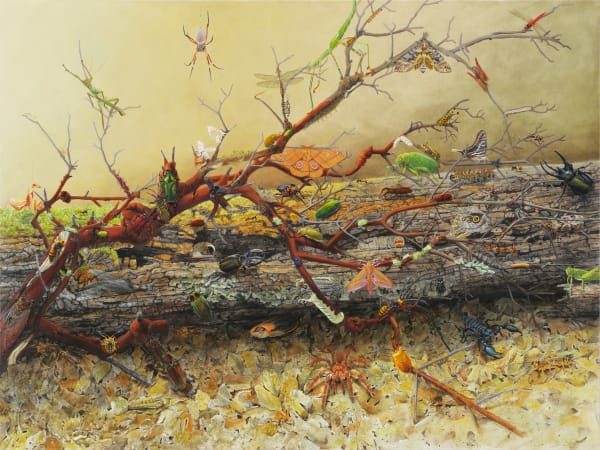
Gallery Conversation: Isabella Kirkland & Dr. Brian L. Fisher
27 May 2021Join us in the gallery from 5-7 pm this Thursday May 27 for a conversation between Isabella Kirkland and prominent Bay Area scientist, Dr. Brian...Read more -

Gallery Conversation: Isabella Kirkland & Lauren Esposito
20 May 2021Join us in the gallery from 5-7 pm this Thursday May 20 for a conversation between Isabella Kirkland and prominent Bay Area scientist, Lauren Esposito,...Read more -
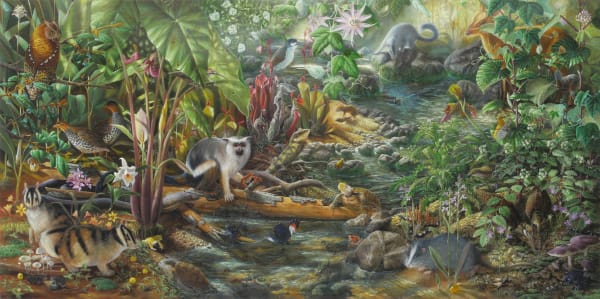
Gallery Conversation: Isabella Kirkland & Ryan Phelan
13 May 2021Join us in the gallery from 5-7 pm this Thursday May 13 for a conversation between Isabella Kirkland and prominent Bay Area scientist, Ryan Phelan....Read more
-

FOG Design + Art 2026
22 - 25 Jan 2026Artworks by Midcentury masters - Harry Bertoia, Bruce Conner, Jay DeFeo, Jess (Burgess Collins) and Wayne Thiebaud - are juxtaposed with pieces by contemporary international...Read more -

ADAA The Art Show: Isabella Kirkland
3 - 7 Nov 2021Hosfelt Gallery presents a solo booth of new paintings by San Francisco Bay Area artist Isabella Kirkland. Self-taught in the meticulous and time-consuming techniques developed...Read more -

PULSE Miami Beach
6 - 9 Dec 2018Our PULSE Miami Beach 2018 booth selection highlights the wide range of our international program with artists from Australia, India, Uruguay, Argentina, England, and the...Read more



































